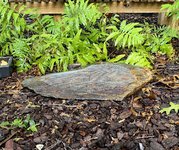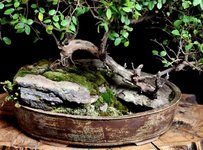b3bowen
Mame
Probably around 5 years ago, I had the idea of making a forest planting of seiryu seedlings. My plan was to plant the forest on a rock slab. I thought the ruggedness of the stone would play well with how dainty the lace leaves are. Seedlings with small dissected leaves and good growth were selected over time. Two years ago a first iteration of the forest was placed in a 3.5 inch deep container, last year it was repotted into a 1.5 inch deep x12 x 18 inch to prepare for slab planting. It is in fine grain akadama, pumice, lava mix.
Photo from early last year.

Here is the prepared slab. It does have drainage holes drilled.

My questions are these.1. I live in 7b north carolina. Will I regret putting these on a slab. I do have automatic irrigation.
2. Should I just take entire planting, place it on slab with minimal disruption, tie down and build muck wall around it. That would leave it in akadama as above. I also purchased premade muck and it was suggested that I plant in 100% muck. Has anyone done this?
Photo from early last year.

Here is the prepared slab. It does have drainage holes drilled.

My questions are these.1. I live in 7b north carolina. Will I regret putting these on a slab. I do have automatic irrigation.
2. Should I just take entire planting, place it on slab with minimal disruption, tie down and build muck wall around it. That would leave it in akadama as above. I also purchased premade muck and it was suggested that I plant in 100% muck. Has anyone done this?





